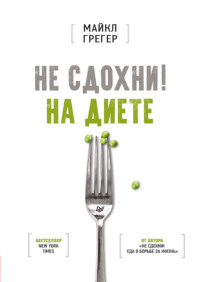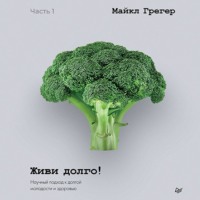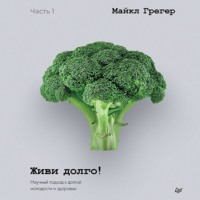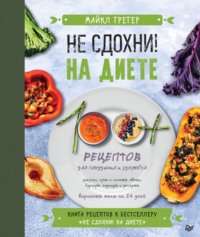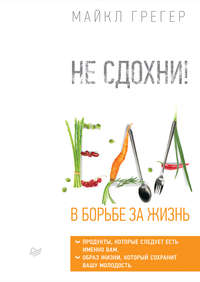
Полная версия
Живи долго! Научный подход к долгой молодости и здоровью
92
Thomson W. Kelvin on science: British lord tells his hopes for wireless telegraphy. The Newark Advocate. https://zapatopi.net/kelvin/papers/interview_aeronautics_and_wireless.html. Published April 26, 1902. Accessed October 24, 2022.; https://zapatopi.net/kelvin/papers/interview_aeronautics_and_wireless.html
93
Ayyadevara S, Alla R, Thaden JJ, Shmookler Reis RJ. Remarkable longevity and stress resistance of nematode PI3K-null mutants. Aging Cell. 2008;7(1):13–22. https://pubmed.ncbi.nlm.nih.gov/17996009/
94
Bartke A, Wright JC, Mattison JA, Ingram DK, Miller RA, Roth GS. Extending the lifespan of long-lived mice. Nature. 2001;414(6862):412. https://pubmed.ncbi.nlm.nih.gov/11719795/
95
Richie JP, Leutzinger Y, Parthasarathy S, Malloy V, Orentreich N, Zimmerman JA. Methionine restriction increases blood glutathione and longevity in F344 rats. FASEB J. 1994;8(15):1302–7. https://pubmed.ncbi.nlm.nih.gov/8001743/
96
Miller RA. Extending life: scientific prospects and political obstacles. Milbank Q. 2002;80(1):155–74. https://pubmed.ncbi.nlm.nih.gov/11933792/
97
Campbell S. Will biotechnology stop aging? IEEE Pulse. 2019;10(2):3–7. https://pubmed.ncbi.nlm.nih.gov/31021750/
98
Faragher RGA. Should we treat aging as a disease? The consequences and dangers of miscategorisation. Front Genet. 2015;6:171. https://pubmed.ncbi.nlm.nih.gov/26236330/
99
de Grey ADNJ. Escape velocity: why the prospect of extreme human life extension matters now. PLoS Biol. 2004;2(6):e187. https://www.ncbi.nlm.nih.gov/pmc/articles/PMC423155/
100
Kurzweil R, Grossman T. Fantastic voyage: live long enough to live forever. The science behind radical life extension questions and answers. Stud Health Technol Inform. 2009;149:187–94. https://pubmed.ncbi.nlm.nih.gov/19745481/
101
Raghavachari N. The impact of apolipoprotein E genetic variability in health and life span. J Gerontol A Biol Sci Med Sci. 2020;75(10):1855–7. https://pubmed.ncbi.nlm.nih.gov/32789475/
102
Medvedev ZA. An attempt at a rational classification of theories of ageing. Biol Rev Camb Philos Soc. 1990;65(3):375–98. https://pubmed.ncbi.nlm.nih.gov/2205304/
103
Willcox DC, Willcox BJ, Poon LW. Centenarian studies: important contributors to our understanding of the aging process and longevity. Curr Gerontol Geriatr Res. 2010;2010:484529. https://pubmed.ncbi.nlm.nih.gov/21804821/
104
Steves CJ, Spector TD, Jackson SHD. Ageing, genes, environment and epigenetics: what twin studies tell us now, and in the future. Age Ageing. 2012;41(5):581–6. https://pubmed.ncbi.nlm.nih.gov/22826292/
105
Kirkwood T. How can we live forever? BMJ. 1996;313(7072):1571. https://pubmed.ncbi.nlm.nih.gov/8990987/
106
Milman S, Barzilai N. Dissecting the mechanisms underlying unusually successful human health span and life span. Cold Spring Harb Perspect Med. 2015;6(1):a025098. https://pubmed.ncbi.nlm.nih.gov/26637439/
107
Ruby JG, Wright KM, Rand KA, et al. Estimates of the heritability of human longevity are substantially inflated due to assortative mating. Genetics. 2018;210(3):1109–24. https://pubmed.ncbi.nlm.nih.gov/30401766/
108
Herskind AM, McGue M, Holm NV, Sørensen TIA, Harvald B, Vaupel JW. The heritability of human longevity: a population-based study of 2872 Danish twin pairs born 1870–1900. Hum Genet. 1996;97(3):319–23. https://link.springer.com/article/10.1007/bf02185763
109
Skytthe A, Pedersen NL, Kaprio J, et al. Longevity studies in GenomEUtwin. Twin Res. 2003;6(5):448–54. https://pubmed.ncbi.nlm.nih.gov/14624729/
110
Ruby JG, Wright KM, Rand KA, et al. Estimates of the heritability of human longevity are substantially inflated due to assortative mating. Genetics. 2018;210(3):1109–24. https://pubmed.ncbi.nlm.nih.gov/30401766/
111
Lee MB, Hill CM, Bitto A, Kaeberlein M. Antiaging diets: separating fact from fiction. Science. 2021;374(6570):eabe7365. https://pubmed.ncbi.nlm.nih.gov/34793210/
112
Search results: “the hallmarks of aging.” WebofScience.com. Accessed February 15, 2023.; https://www.webofscience.com/wos/woscc/summary/55559f9d-7ef6-429d-98f8-f41bc4c102d7-84135d71/relevance/1
113
Levine M, Crimmins E. Not all smokers die young: a model for hidden heterogeneity within the human population. PLoS ONE. 2014;9(2):e87403. https://pubmed.ncbi.nlm.nih.gov/24520332/
114
Devi AS, Thokchom S, Devi AM. Children living with Progeria. Nurs Care Open Access J. 2017;3(4):275–8. https://medcraveonline.com/NCOAJ/children-living-with-progeria.html
115
Ahmed MS, Ikram S, Bibi N, Mir A. Hutchinson-Gilford progeria syndrome: a premature aging disease. Mol Neurobiol. 2018;55(5):4417–27. https://pubmed.ncbi.nlm.nih.gov/28660486/
116
Sosnowska D, Richardson C, Sonntag WE, Csiszar A, Ungvari Z, Ridgway I. A heart that beats for 500 years: age-related changes in cardiac proteasome activity, oxidative protein damage and expression of heat shock proteins, inflammatory factors, and mitochondrial complexes in Arctica islandica, the longest-living noncolonial animal. J Gerontol A Biol Sci Med Sci. 2014;69(12):1448–61. https://pubmed.ncbi.nlm.nih.gov/24347613/
117
Taormina G, Ferrante F, Vieni S, Grassi N, Russo A, Mirisola MG. Longevity: lesson from model organisms. Genes (Basel). 2019;10(7):518. https://pubmed.ncbi.nlm.nih.gov/31324014/
118
Концепция проведения научных исследований с привлечением широкого круга добровольцев-любителей (неспециалистов). – Примеч. ред.
119
Имя Мафусаила, прожившего 960 лет, стало синонимом долгожительства. «Собаками Мафусаила» традиционно называют собак-долгожителей. – Примеч. ред.
120
Jónás D, Sándor S, Tátrai K, Egyed B, Kubinyi E. A preliminary study to investigate the genetic background of longevity based on whole-genome sequence data of two Methuselah dogs. Front Genet. 2020;11:315. https://pubmed.ncbi.nlm.nih.gov/32373156/
121
Kaeberlein M, Creevy KE, Promislow DEL. The Dog Aging Project: translational geroscience in companion animals. Mamm Genome. 2016;27(7–8):279–88. https://pubmed.ncbi.nlm.nih.gov/27143112/
122
Pitt JN, Kaeberlein M. Why is aging conserved and what can we do about it? PLoS Biol. 2015;13(4):e1002131. https://pubmed.ncbi.nlm.nih.gov/25923592/
123
López M. Hypothalamic AMPK: a golden target against obesity? Eur J Endocrinol. 2017;176(5):R235–46. https://pubmed.ncbi.nlm.nih.gov/28232370/
124
Steinberg GR, Macaulay SL, Febbraio MA, Kemp BE. AMP-activated protein kinase – the fat controller of the energy railroad. Can J Physiol Pharmacol. 2006;84(7):655–65. https://pubmed.ncbi.nlm.nih.gov/16998529/
125
Salminen A, Kaarniranta K. AMP-activated protein kinase (AMPK) controls the aging process via an integrated signaling network. Ageing Res Rev. 2012;11(2):230–41. https://pubmed.ncbi.nlm.nih.gov/22186033/
126
Vazirian M, Nabavi SM, Jafari S, Manayi A. Natural activators of adenosine 5’-monophosphate (AMP)-activated protein kinase (AMPK) and their pharmacological activities. Food Chem Toxicol. 2018;122:69–79. https://pubmed.ncbi.nlm.nih.gov/30290216/
127
Jiang S, Li T, Yang Z, et al. AMPK orchestrates an elaborate cascade protecting tissue from fibrosis and aging. Ageing Res Rev. 2017;38:18–27. https://pubmed.ncbi.nlm.nih.gov/28709692/
128
Burkewitz K, Weir HJM, Mair WB. AMPK as a pro-longevity target. In: Cordero MD, Viollet B, eds. AMP-activated Protein Kinase. Experientia Supplementum. Vol 107. Springer; 2016:227–56. https://pubmed.ncbi.nlm.nih.gov/27812983/
129
Ruiz R, Pérez-Villegas EM, Manuel Carrión Á. AMPK function in aging process. Curr Drug Targets. 2016;17(8):932–41. https://pubmed.ncbi.nlm.nih.gov/26521771/
130
Salminen A, Kaarniranta K, Kauppinen A. Age-related changes in AMPK activation: role for AMPK phosphatases and inhibitory phosphorylation by upstream signaling pathways. Ageing Res Rev. 2016;28:15–26. https://pubmed.ncbi.nlm.nih.gov/27060201/
131
Wang S, Kandadi MR, Ren J. Double knockout of Akt2 and AMPK predisposes cardiac aging without affecting lifespan: role of autophagy and mitophagy. Biochim Biophys Acta Mol Basis Dis. 2019;1865(7):1865–75. https://pubmed.ncbi.nlm.nih.gov/31109453/
132
Ruiz R, Pérez-Villegas EM, Manuel Carrión Á. AMPK function in aging process. Curr Drug Targets. 2016;17(8):932–41. https://pubmed.ncbi.nlm.nih.gov/26521771/
133
Mair W, Morantte I, Rodrigues APC, et al. Lifespan extension induced by AMPK and calcineurin is mediated by CRTC-1 and CREB. Nature. 2011;470(7334):404–8. https://pubmed.ncbi.nlm.nih.gov/21331044/
134
Sokolov SS, Severin FF. Manipulating cellular energetics to slow aging of tissues and organs. Biochemistry (Mosc). 2020;85(6):651–9. https://pubmed.ncbi.nlm.nih.gov/32586228/
135
Burkewitz K, Weir HJM, Mair WB. AMPK as a pro-longevity target. In: Cordero MD, Viollet B, eds. AMP-activated Protein Kinase. Experientia Supplementum. Vol 107. Springer; 2016:227–56. https://pubmed.ncbi.nlm.nih.gov/27812983/
136
Миметики – это лекарственные вещества, биохимически имитирующие естественное синтезируемое в организме вещество или вызывающие в организме изменения, сходные с теми, которые проявляются под действием какого-либо внешнего фактора. – Примеч. ред.
137
Burkewitz K, Zhang Y, Mair WB. AMPK at the nexus of energetics and aging. Cell Metab. 2014;20(1):10–25. https://pubmed.ncbi.nlm.nih.gov/24726383/
138
Musi N, Fujii N, Hirshman MF, et al. AMP-activated protein kinase (AMPK) is activated in muscle of subjects with type 2 diabetes during exercise. Diabetes. 2001;50(5):921–7. https://pubmed.ncbi.nlm.nih.gov/11334434/
139
Kola B, Grossman AB, Korbonits M. The role of AMP-activated protein kinase in obesity. Front Horm Res. 2008;36:198–211. https://pubmed.ncbi.nlm.nih.gov/18230904/
140
Narkar VA, Downes M, Yu RT, et al. AMPK and PPARdelta agonists are exercise mimetics. Cell. 2008;134(3):405–15. https://pubmed.ncbi.nlm.nih.gov/18674809/
141
Benkimoun P. Police find range of drugs after trawling bins used by Tour de France cyclists. BMJ. 2009;339:b4201. https://pubmed.ncbi.nlm.nih.gov/19825964/
142
Niederberger E, King TS, Russe OQ, Geisslinger G. Activation of AMPK and its impact on exercise capacity. Sports Med. 2015;45(11):1497–509. https://pubmed.ncbi.nlm.nih.gov/26186961/
143
Niederberger E, King TS, Russe OQ, Geisslinger G. Activation of AMPK and its impact on exercise capacity. Sports Med. 2015;45(11):1497–509. https://pubmed.ncbi.nlm.nih.gov/26186961/
144
Hawley JA, Joyner MJ, Green DJ. Mimicking exercise: what matters most and where to next? J Physiol. 2021;599(3):791–802. https://pubmed.ncbi.nlm.nih.gov/31749163/
145
López-Lluch G, Santos-Ocaña C, Sánchez-Alcázar JA, et al. Mitochondrial responsibility in ageing process: innocent, suspect or guilty. Biogerontology. 2015;16(5):599–620. https://pubmed.ncbi.nlm.nih.gov/26105157/
146
Sharma A, Smith HJ, Yao P, Mair WB. Causal roles of mitochondrial dynamics in longevity and healthy aging. EMBO Rep. 2019;20(12):e48395. https://pubmed.ncbi.nlm.nih.gov/31667999/
147
Hill S, Van Remmen H. Mitochondrial stress signaling in longevity: a new role for mitochondrial function in aging. Redox Biol. 2014;2:936–44. https://pubmed.ncbi.nlm.nih.gov/25180170/
148
López-Otín C, Blasco MA, Partridge L, Serrano M, Kroemer G. The hallmarks of aging. Cell. 2013;153(6):1194–217. https://pubmed.ncbi.nlm.nih.gov/23746838/
149
Gonzalez-Freire M, de Cabo R, Bernier M, et al. Reconsidering the role of mitochondria in aging. J Gerontol A Biol Sci Med Sci. 2015;70(11):1334–42. https://pubmed.ncbi.nlm.nih.gov/25995290/
150
Sgarbi G, Matarrese P, Pinti M, et al. Mitochondria hyperfusion and elevated autophagic activity are key mechanisms for cellular bioenergetic preservation in centenarians. Aging (Albany NY). 2014;6(4):296–310. https://pubmed.ncbi.nlm.nih.gov/24799450/
151
Sengupta P. The laboratory rat: relating its age with human’s. Int J Prev Med. 2013;4(6):624–30. https://pubmed.ncbi.nlm.nih.gov/23930179/
152
Corbisier P, Remacle J. Influence of the energetic pattern of mitochondria in cell ageing. Mech Ageing Dev. 1993;71(1):47–58. https://pubmed.ncbi.nlm.nih.gov/8309283/
153
Burkewitz K, Zhang Y, Mair WB. AMPK at the nexus of energetics and aging. Cell Metab. 2014;20(1):10–25. https://pubmed.ncbi.nlm.nih.gov/24726383/
154
Ruiz R, Pérez-Villegas EM, Manuel Carrión Á. AMPK function in aging process. Curr Drug Targets. 2016;17(8):932–41. https://pubmed.ncbi.nlm.nih.gov/26521771/
155
Wu S, Zou MH. AMPK, mitochondrial function, and cardiovascular disease. Int J Mol Sci. 2020;21(14):4987. https://pubmed.ncbi.nlm.nih.gov/32679729/
156
Agency for Healthcare Research and Quality (AHRQ). Medical Expenditure Panel Survey (MEPS) 2013–2019. ClinCalc DrugStats Database version 2021.10. https://clincalc.com/DrugStats/. Accessed May 22, 2023.; https://clincalc.com/DrugStats/
157
Inzucchi SE, Fonseca V. Dethroning the king?: the future of metformin as first line therapy in type 2 diabetes. J Diabetes Complications. 2019;33(6):462–4. https://pubmed.ncbi.nlm.nih.gov/31003925/
158
Campbell JM, Bellman SM, Stephenson MD, Lisy K. Metformin reduces all-cause mortality and diseases of ageing independent of its effect on diabetes control: a systematic review and meta-analysis. Ageing Res Rev. 2017;40:31–44. https://pubmed.ncbi.nlm.nih.gov/28802803/
159
Glucophage® / Glucophage® XR: Response to FDA Comments of 10 12 00. U.S. Food & Drug Administration: Drugs@FDA. https://www.accessdata.fda.gov/scripts/cder/daf/index.cfm?event=overview.process&ApplNo=021202. Accessed April 25, 2021.; https://www.accessdata.fda.gov/scripts/cder/daf/index.cfm?event=overview.process&ApplNo=021202
160
Braun B, Eze P, Stephens BR, et al. Impact of metformin on peak aerobic capacity. Appl Physiol Nutr Metab. 2008;33(1):61–7. https://pubmed.ncbi.nlm.nih.gov/18347654/
161
Walton RG, Dungan CM, Long DE, et al. Metformin blunts muscle hypertrophy in response to progressive resistance exercise training in older adults: a randomized, double-blind, placebo-controlled, multicenter trial: the MASTERS trial [published correction appears in Aging Cell. 2020;19(3):e13098]. Aging Cell. 2019;18(6):e13039. https://pubmed.ncbi.nlm.nih.gov/31557380/
162
Burkewitz K, Zhang Y, Mair WB. AMPK at the nexus of energetics and aging. Cell Metab. 2014;20(1):10–25. https://pubmed.ncbi.nlm.nih.gov/24726383/
163
Knowler WC, Barrett-Connor E, Fowler SE, et al. Reduction in the incidence of type 2 diabetes with lifestyle intervention or metformin. N Engl J Med. 2002;346(6):393–403. https://pubmed.ncbi.nlm.nih.gov/11832527/
164
Iannello S, Camuto M, Cavaleri A, et al. Effects of short-term metformin treatment on insulin sensitivity of blood glucose and free fatty acids. Diabetes Obes Metab. 2004;6(1):8–15. https://pubmed.ncbi.nlm.nih.gov/14686957/
165
Wen H, Gris D, Lei Y, et al. Fatty acid-induced NLRP3-ASC inflammasome activation interferes with insulin signaling. Nat Immunol. 2011;12(5):408–15. https://pubmed.ncbi.nlm.nih.gov/21478880/
166
Carta G, Murru E, Banni S, Manca C. Palmitic acid: physiological role, metabolism and nutritional implications. Front Physiol. 2017;8:902. https://pubmed.ncbi.nlm.nih.gov/29167646/
167
Fatima S, Hu X, Gong RH, et al. Palmitic acid is an intracellular signaling molecule involved in disease development. Cell Mol Life Sci. 2019;76(13):2547–57. https://pubmed.ncbi.nlm.nih.gov/30968170/
168
Kirwan AM, Lenighan YM, O’Reilly ME, McGillicuddy FC, Roche HM. Nutritional modulation of metabolic inflammation. Biochem Soc Trans. 2017;45(4):979–85. https://pubmed.ncbi.nlm.nih.gov/28710289/
169
Arguello G, Balboa E, Arrese M, Zanlungo S. Recent insights on the role of cholesterol in non-alcoholic fatty liver disease. Biochim Biophys Acta. 2015;1852(9):1765–78. https://pubmed.ncbi.nlm.nih.gov/26027904/
170
Wang XJ, Malhi H. Nonalcoholic fatty liver disease. Ann Intern Med. 2018;169(9):ITC65–80. https://pubmed.ncbi.nlm.nih.gov/30398639/
171
Hydes T, Alam U, Cuthbertson DJ. The impact of macronutrient intake on non-alcoholic fatty liver disease (NAFLD): too much fat, too much carbohydrate, or just too many calories? Front Nutr. 2021;8:640557. https://pubmed.ncbi.nlm.nih.gov/33665203/
172
Luukkonen PK, Sädevirta S, Zhou Y, et al. Saturated fat is more metabolically harmful for the human liver than unsaturated fat or simple sugars. Diabetes Care. 2018;41(8):1732–9. https://pubmed.ncbi.nlm.nih.gov/29844096/
173
Luukkonen PK, Sädevirta S, Zhou Y, et al. Saturated fat is more metabolically harmful for the human liver than unsaturated fat or simple sugars. Diabetes Care. 2018;41(8):1732–9. https://pubmed.ncbi.nlm.nih.gov/29844096/
174
Kirwan AM, Lenighan YM, O’Reilly ME, McGillicuddy FC, Roche HM. Nutritional modulation of metabolic inflammation. Biochem Soc Trans. 2017;45(4):979–85. https://pubmed.ncbi.nlm.nih.gov/28710289/
175
Parry SA, Rosqvist F, Mozes FE, et al. Intrahepatic fat and postprandial glycemia increase after consumption of a diet enriched in saturated fat compared with free sugars. Diabetes Care. 2020;43(5):1134–41. https://pubmed.ncbi.nlm.nih.gov/32165444/
176
Grahame Hardie D. Regulation of AMP-activated protein kinase by natural and synthetic activators. Acta Pharm Sin B. 2016;6(1):1–19. https://pubmed.ncbi.nlm.nih.gov/26904394/
177
Wu Y, Song P, Zhang W, et al. Activation of AMPKa2 in adipocytes is essential for nicotine-induced insulin resistance in vivo. Nat Med. 2015;21(4):373–82. https://pubmed.ncbi.nlm.nih.gov/25799226/
178
Martínez de Morentin PB, Whittle AJ, Fernø J, et al. Nicotine induces negative energy balance through hypothalamic AMP-activated protein kinase. Diabetes. 2012;61(4):807–17. https://pubmed.ncbi.nlm.nih.gov/22315316/
179
Ferguson SG, Shiffman S, Rohay JM, Gitchell JG, Garvey AJ. Effect of compliance with nicotine gum dosing on weight gained during a quit attempt. Addiction. 2011;106(3):651–6. https://pubmed.ncbi.nlm.nih.gov/21182551/
180
Novak CM, Gavini CK. Smokeless weight loss. Diabetes. 2012;61(4):776–7. https://pubmed.ncbi.nlm.nih.gov/22442297/
181
Hadi A, Arab A, Ghaedi E, Rafie N, Miraghajani M, Kafeshani M. Barberry (Berberis vulgaris L.) is a safe approach for management of lipid parameters: a systematic review and meta-analysis of randomized controlled trials. Complement Ther Med. 2019;43:117–24. https://pubmed.ncbi.nlm.nih.gov/30935518/
182
Fouladi RF. Aqueous extract of dried fruit of Berberis vulgaris L. in acne vulgaris, a clinical trial. J Diet Suppl. 2012;9(4):253–61. https://pubmed.ncbi.nlm.nih.gov/23038982/
183
Emamat H, Asadian S, Zahedmehr A, Ghanavati M, Nasrollahzadeh J. The effect of barberry (Berberis vulgaris) consumption on flow-mediated dilation and inflammatory biomarkers in patients with hypertension: a randomized controlled trial [published online ahead of print, 2020 Dec 22]. Phytother Res. 2020;10.1002/ptr.7000. https://pubmed.ncbi.nlm.nih.gov/33350540/
184
Shidfar F, Ebrahimi SS, Hosseini S, Heydari I, Shidfar S, Hajhassani G. The effects of Berberis vulgaris fruit extract on serum lipoproteins, apoB, apoA-I, homocysteine, glycemic control and total antioxidant capacity in type 2 diabetic patients. Iran J Pharm Res. 2012;11(2):643–52. https://pubmed.ncbi.nlm.nih.gov/24250489/
185
McCarty MF. AMPK activation – protean potential for boosting healthspan. Age (Dordr). 2014;36(2):641–63. https://pubmed.ncbi.nlm.nih.gov/24248330/
186
Shidfar F, Ebrahimi SS, Hosseini S, Heydari I, Shidfar S, Hajhassani G. The effects of Berberis vulgaris fruit extract on serum lipoproteins, apoB, apoA-I, homocysteine, glycemic control and total antioxidant capacity in type 2 diabetic patients. Iran J Pharm Res. 2012;11(2):643–52. https://pubmed.ncbi.nlm.nih.gov/24250489/
187
Funk RS, Singh RK, Winefield RD, et al. Variability in potency among commercial preparations of berberine. J Diet Suppl. 2018;15(3):343–51. https://pubmed.ncbi.nlm.nih.gov/28792254/
188
Arayne MS, Sultana N, Bahadur SS. The berberis story: Berberis vulgaris in therapeutics. Pak J Pharm Sci. 2007;20(1):83–92. https://pubmed.ncbi.nlm.nih.gov/17337435/
189
Grahame Hardie D. Regulation of AMP-activated protein kinase by natural and synthetic activators. Acta Pharm Sin B. 2016;6(1):1–19. https://pubmed.ncbi.nlm.nih.gov/26904394/
190
Tavakoli-Rouzbehani OM, Maleki V, Shadnoush M, Taheri E, Alizadeh M. A comprehensive insight into potential roles of Nigella sativa on diseases by targeting AMP-activated protein kinase: a review. Daru. 2020;28(2):779–87. https://pubmed.ncbi.nlm.nih.gov/33140312/
191
Mousavi SM, Sheikhi A, Varkaneh HK, Zarezadeh M, Rahmani J, Milajerdi A. Effect of Nigella sativa supplementation on obesity indices: a systematic review and meta-analysis of randomized controlled trials. Complement Ther Med. 2018;38:48–57. https://pubmed.ncbi.nlm.nih.gov/29857879/
192
Sahebkar A, Beccuti G, Simental-Mendía LE, Nobili V, Bo S. Nigella sativa (black seed) effects on plasma lipid concentrations in humans: a systematic review and meta-analysis of randomized placebo-controlled trials. Pharmacol Res. 2016;106:37–50. https://pubmed.ncbi.nlm.nih.gov/26875640/
193
Sahebkar A, Soranna D, Liu X, et al. A systematic review and meta-analysis of randomized controlled trials investigating the effects of supplementation with Nigella sativa (black seed) on blood pressure. J Hypertens. 2016;34(11):2127–35. https://pubmed.ncbi.nlm.nih.gov/27512971/







